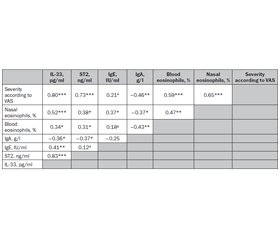Журнал «Здоровье ребенка» Том 18, №6, 2023
Вернуться к номеру
Зміни імунологічних біомаркерів у педіатричних пацієнтів із сезонним алергічним ринітом
Авторы: V.V. Shcherbak, T.O. Kryuchko, L.M. Bubyr, O.V. Izmailova, O.A. Poda
Poltava State Medical University, Poltava, Ukraine
Рубрики: Педиатрия/Неонатология
Разделы: Клинические исследования
Версия для печати
Актуальність. Існує постійна тенденція до зростання частоти сезонного алергічного риніту не лише серед дорослого населення, але й у дитячій популяції. Значний відсоток пацієнтів мають середній та тяжкий перебіг захворювання, що призводить до суттєвого погіршення якості їхнього життя. Оскільки патогенез алергічного риніту представлений складним каскадом імунологічних реакцій із залученням низки цитокінів, що беруть участь у розвитку алергічного запалення верхніх дихальних шляхів, пріоритетним напрямком нашої роботи стало поглиблене вивчення патогенетичних механізмів цього захворювання. Мета: дослідити рівні інтерлейкіну-33 (ІЛ-33) та його рецептора SТ2 у сироватці крові дітей із полінозом залежно від віку та тяжкості перебігу захворювання з наступним визначенням кореляцій цих показників із різними клініко-імунологічними параметрами сезонного алергічного риніту. Матеріали та методи. У дослідженні взяли участь 42 хворі віком 6–17 років із сезонним алергічним ринітом та 26 здорових дітей, які ввійшли в групу контролю. Ступень тяжкості назальних і екстраназальних симптомів алергічного риніту оцінювали за допомогою візуальної аналогової шкали. Шкірне прик-тестування проводилося відповідно до загальноприйнятих стандартів у період ремісії з використанням стандартної пилкової панелі. Кількісне вимірювання сироваткових показників інтерлейкіну-33 та ST2 здійснювали методом твердофазного імуноферментного аналізу. Обов’язковою умовою проведення дослідження була наявність письмової інформованої згоди батьків. Результати. При дослідженні сироваткових рівнів ІЛ-33 та ST2 показано їх статистично вищі значення в групі дітей із тяжким перебігом сезонного алергічного риніту й встановлено пряму кореляцію середньої сили між умістом ІЛ-33 та ST2 у пацієнтів із легким захворюванням (τ = 0,65; p < 0,05) і сильну залежність в осіб із середнім (τ = 0,76; p < 0,01) та тяжким (τ = 0,80; p < 0,05) перебігом. При порівнянні середньостатистичних величин ІЛ-33 та ST2 не було виявлено вірогідних змін залежно від віку та наявності моно- чи полісенсибілізацї серед пацієнтів з алергічним ринітом. В осіб із сезонним алергічним ринітом та супутньою бронхіальною астмою відмічалася тенденція до статистично значимого превалювання більш тяжкого перебігу захворювання з вищими рівнями ІЛ-33 та ST2 порівняно з хворими з ізольованим сезонним алергічним ринітом. Висновки. Отримані результати імунологічного дослідження дозволили підкреслити діагностичну значимість ІЛ-33 та його рецептора ST2 як потенційних біомаркерів розвитку алергічного запалення в пацієнтів педіатричного профілю з сезонними проявами риніту.
Background. Seasonal allergic rhinitis shows a constant upward trend not only among the adults but also in the children’s population. A significant percentage of patients have a moderate and severe course of the disease, which leads to a significant deterioration in their quality of life. Since the pathogenesis of allergic rhinitis is represented by a complex cascade of immunological reactions involving a number of cytokines that play a role in the development of allergic inflammation of the upper respiratory tract, the priority direction of our work was an in-depth study of the pathogenetic mechanisms of this disease. The purpose was to investigate the levels of interleukin-33 (IL-33) and its suppression of tumorigenicity 2 (ST2) receptor in the blood serum of children with hay fever, depending on the age and severity of the disease, followed by the determination of correlations of these indicators with various clinical and immunological parameters of seasonal allergic rhinitis. Materials and methods. Forty-two patients aged 6–17 years with seasonal allergic rhinitis and 26 healthy children (controls) took part in the study. Severity of nasal and extra-nasal symptoms of allergic rhinitis was determined using a visual analog scale. Skin prick testing was performed according to generally accepted standards during remission using a standard pollen panel. Quantitative measurement of serum indicators of interleukin-33 and ST2 was carried out by the method of solid-phase enzyme immunoassay. A mandatory condition for conducting the study was the presence of written informed consent from the parents. Results. The study of serum levels of IL-33 and ST2 showed statistically higher concentrations in the group of children with a severe course of seasonal allergic rhinitis, a direct correlation of medium strength between content of the above cytokines in children with a mild SAR (τ = 0.65; p < 0.05) and a strong dependence in patients with moderate (τ = 0.76; p < 0.01) and severe (τ = 0.80; p < 0.05) course. When comparing the mean values of IL-33 and ST2, no significant changes were found depending on age and the presence of mono- or polysensitisation among patients with allergic rhinitis. In children with seasonal allergic rhinitis and concomitant bronchial asthma, there was a statistically significant tendency towards a more severe course of the disease with correspondingly higher values of IL-33 and ST2 compared to patients with isolated seasonal allergic rhinitis. Conclusions. The obtained results of the immunological study made it possible to emphasize the diagnostic significance of IL-33 and its receptor ST2 as potential biomarkers in the development of allergic inflammation in pediatric patients with seasonal manifestations of rhinitis.
алергічний риніт; біомаркер; цитокіни; бронхіальна астма; діти; алергія
allergic rhinitis; children; biomarker; cytokines; bronchial asthma; allergy

